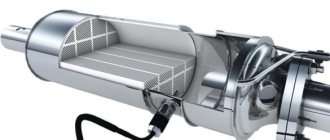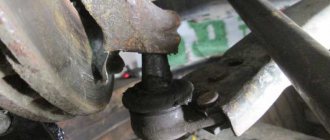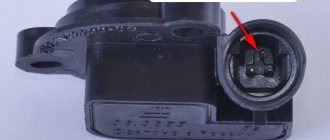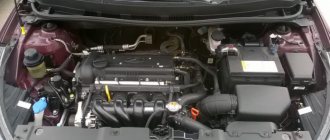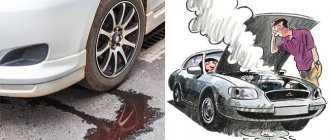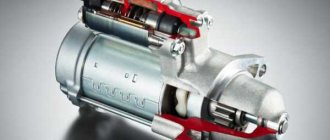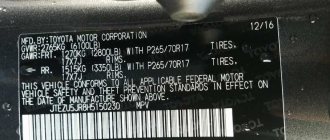Engine power is one of the key characteristics of any internal combustion engine. The power of the power unit directly determines the ability of the power unit to dynamically accelerate the car and maintain the maximum possible speed. It is quite obvious that a noticeable loss of power indicates certain malfunctions of the motor and its systems.
We also recommend reading the article about what engine torque is. From this article you will learn about the relationship between torque and power of the power unit.
A cause for concern is that the car stops accelerating normally on a flat section of the road for no apparent reason. Next, we will look at the reasons why a gasoline engine does not develop full power or a diesel engine does not pull, and we will also talk about diagnostic methods and available ways to eliminate this problem.
Environmental influence
Ambient temperature can reduce the vehicle's traction. This is due to the concentration of oxygen in the atmospheric air.
- When the temperature rises from zero to thirty degrees, the amount of oxygen decreases by about 20%, therefore the efficiency of the motor decreases.
- This is especially noticeable in the mountains: every 100 meters when you rise to a height, the power of your car will decrease by 1%.
- This statement is especially true for 3 or 4 cylinder engines with a volume of up to one and a half liters.
High humidity also reduces engine performance. This effect is achieved due to the displacement of oxygen by water vapor, which, accordingly, reduces the engine thrust. In dry and cool weather the car drives more vigorously. But, as a rule, such changes are insignificant, so not every driver will be able to notice them.
Why is it better to solve the problem with traction at a service station?
Of course, if poor traction is due to a forgotten handbrake or bad fuel, no service will help you. Unless you need to eliminate the problem of increased wear of the brake discs. In other cases, it is better to immediately contact a service station and not experiment with independent repair options. This way you can restore your car in a short time, without having to check possible theories of failure. The main benefits of service in this case for professionals will be the following:
- specialists will find the cause of the problem and will be able to completely restore normal operation;
- the service will recommend that you change your driving habits so that you don’t end up in this situation in the future;
- The company will purchase all spare parts independently, which reduces the risk of purchasing low-quality parts;
- diagnostics will show the exact part that is worth restoring, which can often save you money;
- The repair will be carried out professionally, you will be given a guarantee for the serviceability of the repaired unit.
These are important advantages of servicing your car with specialists, so it is better not to neglect them and get maximum comfort in operating your car. You will often have to overpay for expensive professional services, but this overpayment will definitely pay for itself. After completing the repair at a good station, you will not have to worry about possible repeated problems with traction. However, the health of a car in most cases depends on the driver’s behavior and habits on the road. Therefore, if a certain problem constantly arises in your car, just change your driving style. If you have a domestic car, you can watch the following video describing possible problems when the car loses traction:
Fuel quality
A mismatch in octane rating for a car's engine can result in slow acceleration. Outright counterfeit products, instead of high-quality gasoline, immediately make themselves known. The car may not start immediately, or may not start at all.
- If the car does start, in addition to reduced power, signs of detonation may appear, that is, when the fuel ignites before the required time.
- This will be expressed in a characteristic tapping sound when you press the gas pedal.
- In this case, you can either add higher quality fuel or completely replace the fuel in the tank.
If the problem remains even after draining the counterfeit, you need to take the car to a car dealership to completely flush the car's power system.
Compression
If the car does not pull, the reasons may be compression. To check you will need a compression gauge. It is better if it is equipped with a pressure gauge with good accuracy. When operating the engine, the piston rings are ground off. As a result, compression in the cylinders decreases or disappears altogether. If the timing valves are not installed too tightly in their seats, then the test will show poor results.
To identify the cause of poor compression, after the measurement is completed, add oil to the cylinder and then measure again. If the level has increased slightly, then the piston rings need to be replaced. If you are unlucky and the compression remains the same, then the valves will need to be replaced. If the car does not pull, the reasons (VAZ-2109 is no exception) may be precisely this.
Before measuring compression, the battery should be well charged. Otherwise you will not get the correct indicators. A compression gauge is screwed in instead of spark plugs. This is much better than using a rubber seal. Perhaps, if the car does not pull, the reasons are low compression.
Air filter
The air filter is a barrier between the internal combustion cylinders and the environment that allows air to pass through for fuel combustion. The filter protects the car engine from large particles of dirt, dust, sand so that they do not damage it.
Therefore, the air filter must not only provide protection, but also allow sufficient air to pass through for the engine to operate.
- As the air filter becomes dirty, engine efficiency decreases as less air enters the cylinders.
- Externally for the driver, this can be manifested by detonation, unusual noises, increased fuel consumption and decreased traction, or even jerking of the car.
- In this case, you should replace the faulty air filter before it is too late.
Let's sum it up
Given the rather complex design system of a modern car, the loss of traction may not be felt as much or even not felt at all in daily use. But this is a serious indicator that it is time to carry out a certain set of repair work. Therefore, it is better to listen to the car and try to determine its real problems. If a loss of power is noticed, it is best to immediately go to a service station and fix the problem. This is the only way you can avoid serious damage with quite costly consequences.
If your car has lost power for a long time, you shouldn’t think that this is a natural process of car aging. It is better to set a goal and eliminate all possible causes of this problem. However, loss of power can indeed be a natural process. Major repairs, replacement of original parts with analog ones and other familiar processes for the car owner are a real problem for the operation of the unit. Tell me, have you encountered a sudden loss of power in your car, and how was it decided to deal with this problem?
In general, the engine can stop pulling for a variety of reasons - this is one of the most common malfunctions, which can have a huge variety of reasons, and below we will look at the most likely ones, describe their symptoms and examine this issue in detail. After all, one day something can happen to each of us when the engine loses power, without being accompanied by any further symptoms. The engine probably isn't showing any obvious signs of any illness, it appears to be mostly fine and isn't making any unusual noises or vibrations, but it just doesn't pull as well as it usually does. And the problem seems to be getting worse and worse every day, although you probably didn’t even notice when the engine first started to pull worse.
If you are familiar with this situation, then let's look at the following reasons for the reduction in engine torque:
Poor quality fuel
First of all, you need to blame the fuel - remember where you last refueled - perhaps it’s a new gas station or one whose fuel you have not previously had experience driving with. It is quite possible that the fuel simply turned out to be of very poor quality (it happens that you will simply be lucky if your engine simply stops running - after all, someone’s engine will probably stop starting altogether until the owner completely replaces the fuel in the tank).
If you refuel at the gas station where you usually go, and nothing arouses suspicion, go to local communities on social networks, the car club of your region/district, or just a city portal - perhaps the gas station simply had a bad supply of fuel.
However, most often, coupled with loss of torque, the incompatibility of the engine with such low-quality fuel also has other symptoms - for example, instability of engine speed, difficulty starting and some others, depending on how bad the fuel turned out to be and on the car model.
But you can most likely determine the poor quality of gasoline yourself by unscrewing the spark plugs from the engine (for this you will need a special spark plug wrench) - in general, spark plugs can often be used as the primary diagnostic method for certain malfunctions in the combustion chamber of the engine, since they work together most closely with this combustion chamber and at the same time are quickly removable. If the fuel contains a large amount of metal-based additives, then the contacts of the spark plug and the “skirt” of the central diode will have a reddish coating (as if red brick had been crushed onto the spark plug).
Dirty air filter
You may also simply have your air filter dirty, and in this case, eliminating the loss of power will probably cost you less than all other options - just replace the air filter - you can either buy it yourself or replace it yourself.
The problem with a dirty air filter is that the fuel-air mixture that enters the combustion chamber of your engine's cylinders does not receive enough air, and therefore the fuel does not burn completely, because a sufficient amount of oxygen is needed for its combustion. The situation turns out to be similar to that of a person with a runny nose - he seems to be eating enough and leading a healthy lifestyle, but at certain moments in his life (during illness with this runny nose), clogged nasal passages do not allow him to breathe normally.
Dirty or old spark plugs
The spark plugs may well be fouled or excessively worn, in which case if the engine is not running because of them, it is also a relatively inexpensive option to fix the problem - simply clean the spark plugs or replace them. However, it should be borne in mind that both periodic contamination and wear of spark plugs is an abnormal process, and the reason for this most likely lies somewhere deeper, or in the spark plugs themselves.
Dirty fuel filter
The fuel filter, like the air filter, can cause a loss of engine power. And the physics of the process here is similar to the air filter - if in the case described above the fuel did not burn completely due to lack of air, then in the case of a dirty fuel filter, on the contrary, an insufficient amount of fuel is supplied. In this case it's simple.
Mechanical problems with the engine
If all of the above methods did not help, and the engine still pulls the car poorly, then it’s time to entrust the matter to professionals - stop by a good car service and diagnose the engine’s operation - checking the compression (compression ratio in the combustion chambers), for example, can say a lot about the operation engine, including information about approaching its service life limit and upcoming expensive repairs.
Fuel system malfunction
It is quite likely that the reason for the drop in engine torque is a violation of the normal operation of the fuel supply system to the cylinders, and there may also be a number of reasons why the engine does not gain speed, let’s list the main ones:
- Faulty (dirty) fuel pump due, for example, to low-quality fuel or gasoline being sucked out from the bottom of the tank, where most of the foreign dirt particles have settled.
- Malfunction of the injector or oxygen sensor.
- Leaks in fuel supply hoses or tubes where air is sucked in.
The catalytic converter or exhaust system is clogged
A contaminated catalytic converter or exhaust system line can also cause a decrease in engine torque. In both cases, replacing the corresponding contaminated component will help. It should be borne in mind that the catalyst, as a rule, is very expensive due to the content of noble metals in certain quantities.
We have listed the main and most probable reasons for a possible loss of engine power - you need to remember that there are a great many such reasons, and if you were unable to establish them yourself, then you must definitely go to a car service workshop to entrust this matter to professionals.
Modern engines have good power, a sufficient level of efficiency, and pollute the environment less. When the behavior of the power unit changes, it is immediately noticeable. If the car does not pull, the reasons for this phenomenon can be very different. Let's look at them.
An engine can lose traction for various reasons. There are a huge number of different faults that result in loss of power. Sometimes cravings go away without any symptoms. The unit does not make unusual noises, does not vibrate - it just has lost traction. Every day the car drives worse and worse. This situation is probably familiar to every motorist.
Exhaust system
The exhaust system is an important element in a car, the main function of which is to remove gases that appear during operation of the car.
An exhaust malfunction that is not diagnosed in time can lead to the melting of engine parts by hot gases or the penetration of these gases into the passenger compartment, as well as contribute to rapid wear of the chassis.
- Reduced exhaust capacity leads to a natural decrease in engine performance and poor acceleration, respectively.
- The solution to the problem may be to replace the catalyst, which reduces the level of emissions of harmful substances into the environment.
- Banal removal is a budget option for fixing the problem, but not the best.
- There will certainly be noise in the exhaust system, and the car owner may smell exhaust gases in the cabin while the engine is running.
Stop driving with the handbrake, and traction will appear by itself
If you always set your car's handbrake but forget to release it while driving, prepare for compromised traction. When driving with the handbrake, you get the feeling that the car accelerates very slowly and it is too difficult to gain momentum. The driver immediately puts pressure on the engine, putting pressure on the suspension or gearbox. But he can’t even think that it’s enough to lower the handbrake lever for the problem to solve itself. Moreover, driving with the handbrake for quite a long time will cause the following troubles with the car:
These are the troubles that await you if you simply forget to remove the handbrake lever to its original position before moving off. If you have a manual transmission, keeping an eye on the handbrake becomes even more difficult. With an automatic, it is enough not to accelerate from the first second, but to let the car show its readiness for the trip, let it start idling. If you regularly leave the handbrake on, just stop using the handbrake. Leave it in gear, choose more or less level parking spots.
Gasoline pump
The fuel pump is responsible for pumping fuel from the tank to the engine and stabilizing the pressure in the power system. A malfunction in such an important element can lead to insufficient engine performance - it can stall right in the middle of operation, fail to start for no reason, or take a long time to accelerate the car.
On injection engines, you need to occasionally clean or change the fuel pump mesh filter, which will avoid further problems with the car.
Why the car doesn't pull: reasons (carburetor)
If such an engine loses traction, the fuel pump fitting may be dirty or there may be low pressure in the system.
It is also possible that the carburetor is simply dirty or there is some problem with the needle valve. There may be errors or incorrect settings for adjusting the composition of the fuel mixture. If the carburetor flaps are not open enough, traction may be lost. When the fuel level in the engine decreases, traction also disappears. When there are any problems with traction in the engine, it is urgent to carry out a full diagnosis.
You definitely need to find out why the car pulls poorly; we have already looked at the reasons. If a malfunction is found, it should be corrected immediately. If you could not find the reason for the decrease in cravings on your own, there is no need to hesitate. A more in-depth examination should be carried out at the service station. But basically, the cause can still be identified and eliminated independently.
So, we found out why the car loses traction.
If the car does not show its former power and traction, you will not get any pleasure from driving. Moreover, the consumption of gasoline or diesel fuel often increases, and the risk of failure of any units increases. The car owner intuitively understands that something is wrong in the design of the vehicle. Therefore, there is a desire to check the car, find the cause of the defect and get specific solutions to the problem. Today we will talk about why the car does not pull, and also what needs to be done in such situations, where you should look first. If you encounter such a problem suddenly, it is worth quickly diagnosing the main components of the machine, identifying the problem and eliminating the cause of the loss of power. If the problem has been present for a long time, it’s time to go to a service station and solve this issue.
If you drive for a long time with most of the problems that cause loss of traction, you can completely ruin the power unit and end up needing expensive repairs. So we strongly recommend that you immediately pay attention to a noticeable loss of engine power or a real feeling that someone is holding you by the exhaust pipe and is not allowing you to accelerate. The longer you think it will go away over time, the more damage you can do to your car. This will also cause excessively expensive repairs in the long run. Let's consider the main reasons for this phenomenon.
Fuel system
A dirty power system will not be able to supply the required amount of gasoline or diesel to the engine. This leads to a redistribution of the fuel-air ratio, the latter in the engine becomes much larger, which also affects the acceleration of the car.
- The cause may be a dirty fuel filter or injector.
- They need to be cleaned every 20 thousand kilometers, or replaced with new ones.
Air flow and pressure sensor
These two elements determine how much air the engine consumes, as well as how much air is needed to create the optimal air-fuel mixture. If these sensors fail, then the ECU will not make the calculations correctly and, accordingly, traction may be lost. If the car does not pull, the reasons (including the VAZ-2110 injector) may be in these sensors. If necessary, they should be replaced, and then the power will return again.
But if the car has an ECU, why doesn’t the corresponding light on the dashboard light up? The electronic control unit is programmed for an open or short circuit. If there is none of this, and the sensor simply does not work as it should, the computer will be able to report that the mixture is being prepared incorrectly. If the car pulls poorly, there may be other reasons, but it’s worth checking the sensor. You will have to look for the source of the sensor’s malfunction yourself. The parameters of a specific element can be found in the instructions.
Engine
Wear or breakdown of the engine or its parts naturally leads to a disruption in mixture formation, that is, the air-fuel ratio changes, which, in turn, interferes with its full operation.
In this case, comprehensive diagnostics are needed to check whether there is an air leak at the inlet or a fuel leak.
4) Low battery
The service life of car batteries is on average 3-4 years, or 80,000-100,000 km. The battery usually ages over time, just like any battery in your smartphone. The more often a battery goes through discharge/charge cycles, the faster it loses its ability to maintain a normal charge level and a certain number of amps. This is why old batteries in your phone and car charge quickly and discharge just as quickly.
Including a damaged alternator and other charging components can precipitate battery problems
This is why it is important to replace the old battery after about 80,000 km, or 3 years after use (whichever comes first). Moreover, this is worth doing even if there are no signs of battery wear
Agree, it is better not to wait for a situation when, leaving work or a shopping center in severe frost, you cannot start the engine.
Tires
Sometimes underinflated or overinflated tires can affect acceleration speed. Poorly inflated tires increase the area of contact with the road and, accordingly, make it difficult for the car to accelerate.
Oddly enough, overinflating tires also affects acceleration dynamics, but by reducing the contact area.
- It is worth paying attention to the difference in pressure in all tires.
- If there is one, the car will be pulled towards the underinflated wheels.
- The result is a decrease in speed, acceleration and controllability of the car.
What to do if you need to leave your car idle for a long time
In case of forced downtime, take a number of preventive measures to minimize the harm of long-term parking of the car:
- Fill the tank with high-quality gasoline;
- Change transmission and engine oil;
- Disconnect the battery from the car. For the winter, move it to a heated room, remembering to periodically recharge;
- Lubricate all rubber seals with a lubricant containing silicone;
- Protect your car from excess moisture by covering it with a cover.
It is recommended, in order to avoid stagnation, to at least periodically roll the car for several meters. Although, if possible, warm up the car and drive at least a few hundred meters. In this way, you will restore the performance of consumables, and also prevent aging and corrosion of parts.
View the discussion thread.
Clutch malfunction
A properly functioning clutch ensures the transfer of torque from the engine to the transmission. It is interesting that problems with the clutch can occur not only in “mechanics”, but also in “automatics”, “variations” and “robots”.
Clutch problems in different types of cars are caused by different mechanisms, but from the outside, a clutch malfunction looks the same.
That is, the engine picks up speed and roars bravely, but the car itself accelerates very slowly. In other words, the clutch slips, which significantly and noticeably affects the acceleration dynamics.
Checking the transmission
Sometimes the power unit can develop serious power, but it does not reach the wheels. If while driving you hear that the engine is working hard, but you don’t feel speed, then perhaps the automatic transmission system is slipping or there are blockages on the brakes.
To check, you need to drive onto a straight section, set the automatic transmission selector to position D, and then see how the car behaves. If the speed decreases, then diagnostics should be carried out. If everything is in order with the brakes, you need to go to a good service station and check the automatic transmission.
You can also check the parking brake. To do this, you need to go to free space. Warm up the car and then pull the handbrake. Next, press the brake pedal and set it to position D. Next, press the accelerator. If the engine keeps the rpm around 2000, then everything is fine with it. If it is less or more, you should go to a service station to test the automatic transmission.
Braking system
It happens that the brake pads can mechanically interfere with the wheels, slowing down the vehicle. The cause may be a stuck brake piston or improperly adjusted parking brake.
7) Generator failure
The alternator is the part of your car that keeps all the electrical systems running when you start the car. It is also responsible for supplying charge to the battery to keep it in peak condition. If the alternator breaks down, it can cause premature battery wear and other problems when starting the car.
Check your machine manual or service book for recommended maintenance intervals for your generator and replace it before it breaks to avoid problems.
Also note that many generators can be iterated over. This way you can save a lot of money.
